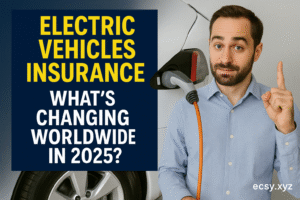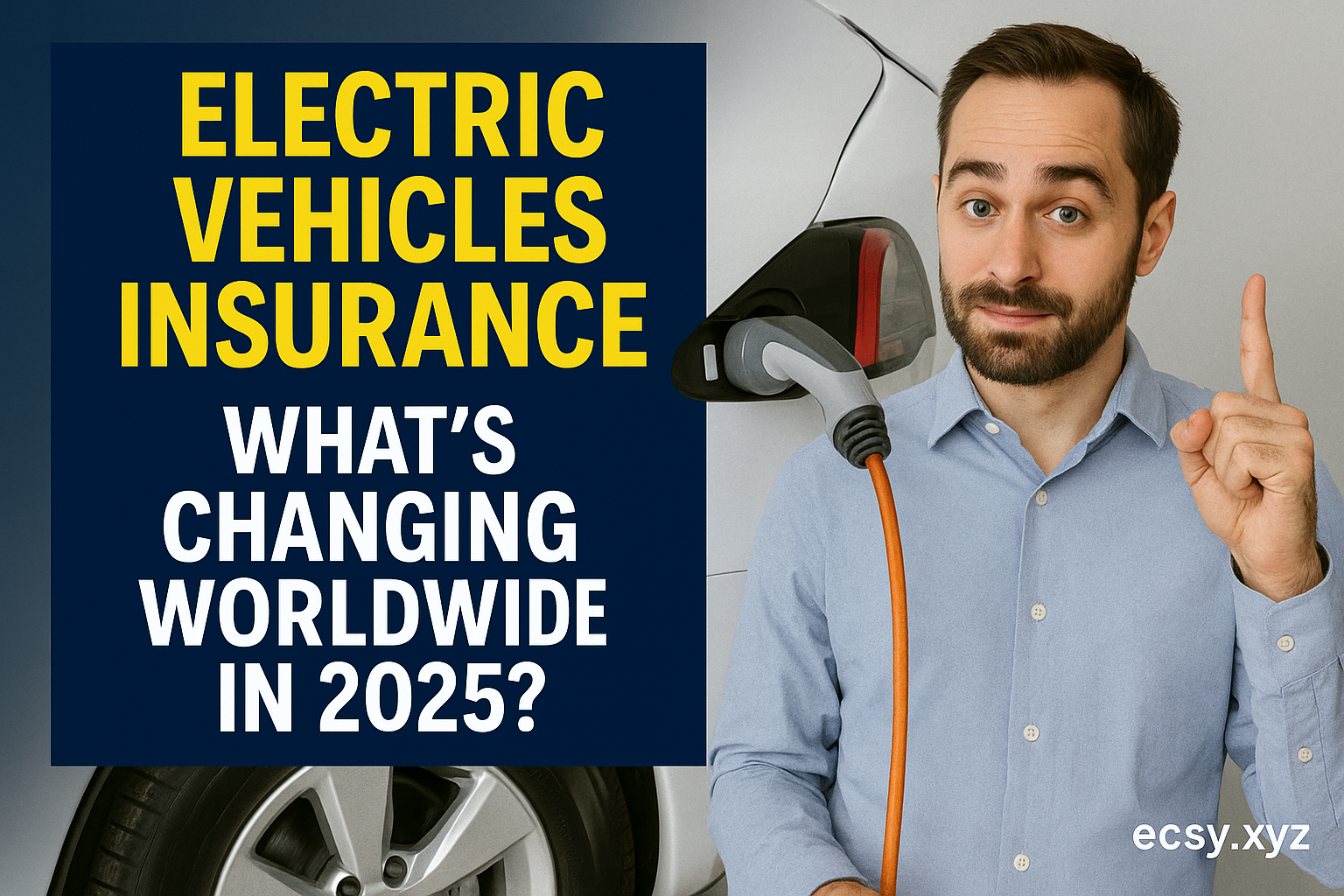As we accelerate into 2025, electric vehicles (EVs) are no longer a fringe innovation—they are rapidly becoming the mainstream choice for private, commercial, and public transportation globally. This seismic shift is triggering a parallel transformation in the vehicle insurance industry, prompting insurers, regulators, and vehicle owners to rethink policies, premiums, and coverage models.
EV Market Growth and Its Impact on Insurance
The global EV market is projected to grow to over 60 million units sold annually by 2030, but 2025 is proving to be the pivotal year of transition. Governments, led by countries like Norway, China, Germany, and the UK, are offering aggressive incentives, tax rebates, and regulatory pushes to phase out internal combustion engines (ICEs).

With this growth comes insurance complexity. Traditional auto insurance models, built for gasoline-powered vehicles, struggle to price the risk and value associated with EVs, which have different repair costs, driving behaviors, battery risks, and software vulnerabilities.
Higher Repair Costs: A Key Pricing Challenge
EVs feature advanced electronics, sensors, and battery systems that make them expensive to repair after accidents. Even minor damage to the battery casing can lead to the replacement of the entire battery module, which may cost upwards of $10,000. In many markets, insurers are forced to declare EVs a total loss for incidents that would be minor for ICE vehicles.
Because of this, insurers in 2025 are recalibrating comprehensive coverage premiums. Countries like the United States, Canada, and the Netherlands are seeing average premiums for EVs up to 25% higher than for traditional cars—although this is expected to stabilize as more specialized EV repair networks emerge.
Battery Health and Warranty Integration in Policies
A game-changer in 2025 is the incorporation of battery health diagnostics into insurance underwriting. EV batteries lose capacity over time, and insurers now demand access to battery telematics to assess risk.
OEMs (Original Equipment Manufacturers) like Tesla, BYD, and Ford offer extended battery warranties, and insurers are collaborating with these manufacturers to integrate battery warranty data into policy conditions. This partnership helps determine whether the battery’s degradation is covered under warranty or needs insurance compensation.
Cybersecurity Risks: A Rising Threat
With increasing reliance on autonomous driving systems, over-the-air updates, and connected services, EVs are becoming targets for cyberattacks. In 2025, cyber coverage is becoming a standard clause in EV policies, especially in jurisdictions where vehicles must remain online for safety compliance.
Major insurers in Germany and South Korea now provide cyber insurance add-ons, covering issues like malware infiltration, GPS spoofing, and remote hijacking of vehicle systems. This trend is growing, especially for commercial EV fleets.
Usage-Based Insurance (UBI) for EV Drivers
EV drivers, especially those using vehicles for ride-sharing or delivery, benefit from usage-based insurance models. Through real-time telematics, insurers now offer policies that reflect actual driving behavior, such as speed, acceleration, charging habits, and route patterns.
In 2025, insurers in countries like India, Australia, and the UK have launched UBI plans tailored for EVs, where safer, energy-efficient drivers receive significant discounts. This model promotes responsible driving and helps reduce the overall carbon footprint.
Specialized EV Insurance Products
Traditional auto insurance is being replaced by EV-specific insurance products in markets like California, Sweden, and Japan. These policies focus on:
-
Battery replacement coverage
-
Charging station liability
-
Software and firmware malfunction
-
EV towing and roadside assistance
-
Home charging unit damage
Insurers are bundling these features into exclusive packages for EV owners, offering tailored solutions that address real-world usage scenarios.
Regulatory Evolution and Mandates
Governments are stepping in to ensure insurance keeps pace with EV growth. The European Union, for instance, mandates that all EV insurance policies provide battery lifecycle disclosure and coverage clarity. The U.S. National Association of Insurance Commissioners (NAIC) is also updating its Vehicle Risk Index to include EV-specific criteria.
Meanwhile, China has rolled out centralized EV insurance platforms, ensuring transparency, fraud control, and price consistency across provinces. By 2025, regulators worldwide are establishing EV insurance task forces to build consumer trust and modernize insurance frameworks.
EV Fleet Insurance: A Fast-Growing Segment
Companies deploying EV fleets, such as Amazon, FedEx, and Uber, now require fleet-wide insurance solutions that cover:
-
Bulk battery risks
-
Depreciation due to high mileage
-
Fast-charging-related degradation
-
Autonomous delivery vehicle risk
Fleet policies in 2025 focus on efficiency, predictive analytics, and risk pooling. Insurers use AI-powered tools to proactively adjust premiums based on fleet-wide telematics data.
Green Insurance Incentives
To encourage the adoption of EVs, many insurers now offer green discounts. These incentives include:
-
Lower premiums for zero-emission vehicles
-
Bonuses for installing solar-powered home chargers
-
Credits for offsetting emissions via carbon offset programs
In France and New Zealand, insurers are leading climate-positive initiatives by issuing certified green insurance products, which attract environmentally conscious policyholders.
Insurance for EV Charging Infrastructure
EV charging is no longer just a utility—it’s a liability and risk area. In 2025, insurers are offering dedicated policies for:
-
Public and private EV charging stations
-
Damage from surges or overheating
-
Cable theft and vandalism
-
Third-party injuries
Owners of charging infrastructure, whether residential or commercial, must now comply with insurance minimums, particularly in Europe and the U.S.
Autonomous and Semi-Autonomous EV Insurance
The rise of self-driving EVs in 2025, especially in pilot programs in San Francisco, Shenzhen, and Dubai, has introduced novel insurance dynamics. With liability shifting between driver, vehicle, and software provider, insurers now offer multi-layered coverage:
-
Driver error liability
-
Software malfunction
-
Sensor calibration errors
-
Shared fault arbitration
These layered policies are often brokered through AI-driven platforms capable of parsing vehicle logs and determining liability in real time.
Conclusion: The Future of EV Insurance is Digital, Dynamic, and Data-Driven
The insurance industry in 2025 is no longer reactive—it’s predictive and adaptive, especially in the EV sector. As we move toward greater electrification, automation, and connectivity, insurers must continuously evolve to meet emerging challenges. By integrating telematics, AI, cybersecurity, and environmental metrics, the next generation of EV insurance will not only protect but also empower users to drive smarter, safer, and greener.
EV Insurance Innovations by Region
United States: A Hub of Telematics and InsurTech
In the U.S., InsurTech startups are leading the evolution of EV insurance with AI-driven platforms and on-demand coverage models. Companies like Root, Metromile, and Tesla Insurance are integrating vehicle data directly from the EV to dynamically adjust premiums.
Tesla, for example, offers real-time insurance quotes based on daily Safety Scores, encouraging safer driving habits while reducing insurance costs. Meanwhile, traditional giants like State Farm and Allstate are partnering with tech firms to remain competitive, introducing app-based policy management, instant claims processing, and remote diagnostics for EVs.
Europe: Regulatory Consistency and Green Coverage
Europe continues to lead with regulatory sophistication and eco-conscious insurance mandates. The European Green Deal is accelerating insurer compliance with climate objectives, and insurers are now obliged to provide carbon footprint disclosures for all vehicle policies.
In Germany, firms like Allianz are offering modular EV policies that allow policyholders to customize coverage based on vehicle usage, autonomy level, and battery type. France and Norway offer further incentives through no-claims discounts tailored for EVs and government-backed subsidies for insurance on low-emission vehicles.
Asia-Pacific: Fastest Growing EV Insurance Market
China and India are two of the largest and fastest-growing EV markets, and both are seeing rapid innovation in insurance. In China, state-supported insurers are integrating 5G-enabled diagnostics and drone-assisted damage assessments to streamline claims. The People’s Insurance Company of China (PICC) now offers fully digital EV insurance that’s linked to national vehicle databases, ensuring real-time data access.
In India, insurers like Tata AIG and Bajaj Allianz have begun offering EV-only policies, bundled with battery leasing protection, charger damage, and EV theft add-ons. Government-backed platforms like IRDAI’s digital sandbox are also helping test new EV policy frameworks.
Middle East & Africa: Emerging but Promising
While EV adoption is slower in this region, nations like United Arab Emirates and South Africa are laying foundations. Dubai’s RTA and insurers are piloting pay-per-kilometer EV policies, especially for shared and autonomous fleets. These initiatives also focus on insurance interoperability between public and private charging providers, a crucial step as EV infrastructure expands.
The Shift Towards Embedded Insurance
In 2025, the concept of embedded insurance is revolutionizing how EV policies are sold and managed. Instead of shopping for insurance separately, buyers of EVs from OEMs like Rivian, Lucid Motors, Hyundai, and Volkswagen are now offered instant policy activation at the point of sale.
This seamless model enables:
-
Real-time underwriting using vehicle and driver profile data
-
Policy bundling with EV financing or leasing agreements
-
Ongoing premium adjustments based on vehicle diagnostics
Such models are especially beneficial for fleet operators, who can manage multiple vehicle policies through a centralized dashboard, reducing administrative overhead.
Claims Management: Faster, Smarter, and Fully Digital
Modern EV insurance policies focus on rapid claims resolution using technology such as:
-
AI-powered damage estimation through image recognition
-
Blockchain for secure claims verification
-
Virtual adjusters who assess damage via live video
In 2025, insurers like Zurich and AXA offer claim settlements within 24–48 hours, a far cry from the traditional paper-heavy processes. Claims for issues such as battery leakage, charger fires, or autonomous mishaps are now categorized and resolved based on automated severity scoring algorithms.
EV Insurance: Preparing for 2030 and Beyond
The innovations seen in 2025 are just the beginning. Looking ahead, EV insurance is expected to include:
-
Integration with smart grids: Insurance discounts for charging during off-peak hours
-
Climate resilience scoring: Policies influenced by how EVs perform in extreme weather
-
Subscription-based insurance: Users pay monthly fees like they would for streaming services
-
Global EV insurance IDs: Cross-border policy recognitions for global EV travelers
As vehicles become software-defined and data-centric, insurance will transform from a safety net into a dynamic risk mitigation ecosystem, playing an essential role in the future of smart mobility.
Final Thoughts: Embracing the EV Insurance Revolution
The EV boom is not just changing the way we drive—it’s reinventing how we insure, interact, and think about vehicle ownership. With the convergence of AI, sustainability goals, smart infrastructure, and digital innovation, 2025 marks the dawn of a smarter insurance era tailored for the electric future.
Insurers who adapt to this transformation—offering personalized, usage-based, and eco-conscious coverage—will not only thrive in the new automotive landscape but also contribute to a more responsible and connected world.
For drivers, fleet operators, and cities alike, now is the time to embrace insurance that aligns with tomorrow’s mobility—intelligent, ethical, and electrified.

